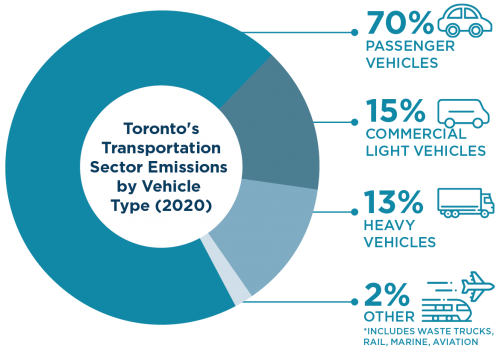
 Transportation is the second largest source of GHG emissions in Toronto, accounting for 33 per cent of total emissions. Fossil fuels power our cars, trucks, ships, trains and planes, resulting in GHG emissions. Most (70 per cent) of the transportation emissions come from our personal vehicles (e.g. cars, vans, SUVs and light trucks used by individuals or households).
Transportation is the second largest source of GHG emissions in Toronto, accounting for 33 per cent of total emissions. Fossil fuels power our cars, trucks, ships, trains and planes, resulting in GHG emissions. Most (70 per cent) of the transportation emissions come from our personal vehicles (e.g. cars, vans, SUVs and light trucks used by individuals or households).
To meet our 2030 reduction targets and ultimately achieve net zero by 2040, we need to reduce vehicular trips as much as possible by switching to walking, cycling or transit while facilitating a rapid transition from internal combustion vehicles to electric vehicles.
The TransformTO Net Zero Strategy includes the following transportation targets. By 2030:
Learn more about how the City of Toronto is supporting low carbon transportation options.
Cycling is one of the fastest growing transportation modes in Toronto. The City is working to make travel by bike safer and more inviting, which helps ease congestion on streets and transit, creates a cleaner environment, and promotes physical activity. Check out Smart Commute for tips on incorporating cycling into your commute.
The City supports cycling by building and maintaining infrastructure such as bike lanes and multi-use trails, installing bike parking facilities, distributing bike network maps, and carrying out other campaigns and projects to promote cycling confidence and safe road use behaviour. Learn more about cycling in Toronto.
Walking is a great way to get to and from work and school, or to a transit station. It produces no negative impacts to the environment and has physical as well as mental health benefits. Walking can allow you to appreciate your surroundings, discover a new part of the city, and get some exercise. Learn more about walking in Toronto.
Transit in Toronto is an integrated multi-modal system made up of local and regional services, integral to the city and region’s vitality. The City’s local transit agency, the Toronto Transit Commission (TTC), operates the third-largest system in North America. Our infrastructure needs to be maintained and expanded to meet our growth. As we continue to modernize our service, we are also introducing green initiatives that are essential to our goals of net zero emissions by 2040.
As part of this commitment, the TTC’s bus fleet is comprised of three different eco-friendly technologies that include clean diesel, hybrid electric and battery electric. Learn more about transit in Toronto.
Switching from fossil fuel-powered vehicles to electric vehicles for trips not taken by walking, cycling, or transit is important for meeting the City’s goal of achieving net zero GHG emissions by 2040. Electric vehicles have other benefits, too. They cost less to operate and don’t have tailpipe emissions, helping to reduce air pollution. They are also quiet, helping to reduce noise pollution.
Through its Electric Vehicle Strategy, the City is supporting the transition to electric vehicles, including supporting EV charging in homes and workplaces and the development of a robust public EV charging network. This City is also demonstrating leadership by electrifying its own fleet and transit vehicles. Learn more about electric vehicles.